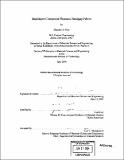| dc.contributor.advisor | Yoel Fink. | en_US |
| dc.contributor.author | Hart, Shandon D. (Shandon Dee), 1978- | en_US |
| dc.contributor.other | Massachusetts Institute of Technology. Dept. of Materials Science and Engineering. | en_US |
| dc.date.accessioned | 2006-03-29T18:28:56Z | |
| dc.date.available | 2006-03-29T18:28:56Z | |
| dc.date.copyright | 2004 | en_US |
| dc.date.issued | 2004 | en_US |
| dc.identifier.uri | http://hdl.handle.net/1721.1/32264 | |
| dc.description | Thesis (Ph. D.)--Massachusetts Institute of Technology, Dept. of Materials Science and Engineering, 2004. | en_US |
| dc.description | Includes bibliographical references (leaves 120-126). | en_US |
| dc.description.abstract | Materials and fabrication techniques are developed that lead to the successful fabrication of multilayer composite photonic bandgap fibers. The pertinent background in electromagnetic theory of multilayer dielectric mirrors and optical fibers is surveyed. Materials properties constraints are outlined, with emphasis on those constraints related to processing strategy and ultimate target length scale. Interfacial energy is measured in a chalcogenide glass / organic polymer composite system selected for fiber fabrication. A classical capillary instability model is employed to predict the feasibility of fiber fabrication based on material properties; from this model, quantitative materials selection criteria related to ultimate length scale are derived. Good agreement is found between the calculated materials selection criteria and controlled fiber experiments. The fiber fabrication techniques are described and analyzed; chalcogenide film deposition is characterized using Raman and electron microprobe spectroscopy, and heat transfer during fiber drawing is modeled using a commercial finite-element software package. The developed materials and fabrication processes are used to perform two case studies in novel photonic bandgap fiber fabrication; the first case study deals with externally reflecting omnidirectional 'mirror-fibers', while the second deals with hollow- core light transmitting fibers. The reflecting mirror-fibers consist of a tough polymer core surrounded by multiple coaxial submicron-thick layers of a high-refractive-index glass and a low-index polymer; these layers reflect external light from all incident angles and polarizations in the mid-IR range. | en_US |
| dc.description.abstract | (cont.) Large directional photonic gaps and high reflection efficiencies that are comparable to the best metallic reflectors were measured. In the second case study, the light-transmitting fibers consist of a hollow air core surrounded by multiple alternating layers of the same materials, resulting in large infrared photonic bandgaps. Optical energy is strongly confined in the hollow fiber core, enabling light guidance in the fundamental and up to fourth-order gaps. These gaps are placed at selectable wavelengths within a large selection range, from 0.75 to 10.6 m. Tens of meters of hollow photonic bandgap fibers designed for 10.6 pgm radiation transmission are fabricated. We demonstrate transmission of carbon dioxide (CO2) laser light with high power-density through more than 4 meters of hollow fiber and measure the losses to be less than 1.0 dB/m at 10.6 microns. Thus, fiber waveguide losses are suppressed by orders of magnitude compared to the intrinsic fiber material losses. | en_US |
| dc.description.statementofresponsibility | by Shandon D. Hart. | en_US |
| dc.format.extent | 126 leaves | en_US |
| dc.format.extent | 6020400 bytes | |
| dc.format.extent | 6018127 bytes | |
| dc.format.mimetype | application/pdf | |
| dc.format.mimetype | application/pdf | |
| dc.language.iso | eng | en_US |
| dc.publisher | Massachusetts Institute of Technology | en_US |
| dc.rights | M.I.T. theses are protected by copyright. They may be viewed from this source for any purpose, but reproduction or distribution in any format is prohibited without written permission. See provided URL for inquiries about permission. | en_US |
| dc.rights.uri | http://dspace.mit.edu/handle/1721.1/7582 | |
| dc.subject | Materials Science and Engineering. | en_US |
| dc.title | Multilayer composite photonic bandgap fibers | en_US |
| dc.title.alternative | Composite photonic bandgap fiber materials and fabrication | en_US |
| dc.type | Thesis | en_US |
| dc.description.degree | Ph.D. | en_US |
| dc.contributor.department | Massachusetts Institute of Technology. Department of Materials Science and Engineering | |
| dc.identifier.oclc | 56028121 | en_US |
